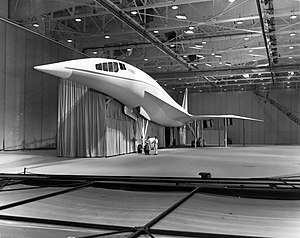
Back لوكهيد إل-2000 Arabic Lockheed L-2000 German Lockheed L-2000 Spanish لاکهید ال-۲۰۰۰ Persian Lockheed L-2000 Finnish Lockheed L-2000 French Lockheed L-2000 ID Lockheed L-2000 Italian ロッキード L-2000 Japanese Lockheed L-2000 Portuguese
This article includes a list of references, related reading, or external links, but its sources remain unclear because it lacks inline citations. (April 2009) |
| Lockheed L-2000 | |
|---|---|

| |
| Full-scale mockup of the L-2000-7 design | |
| Role | Supersonic airliner |
| Manufacturer | Lockheed Corporation |
| Status | Canceled in 1971 |
The Lockheed L-2000 was Lockheed Corporation's entry in a government-funded competition to build the United States' first supersonic airliner in the 1960s. The L-2000 lost the contract to the Boeing 2707, but that competing design was ultimately canceled for political, environmental and economic reasons.
In 1961, President John F. Kennedy committed the government to subsidize 75% of the development of a commercial airliner to compete with the Anglo-French Concorde then under development. The director of the Federal Aviation Administration (FAA), Najeeb Halaby, elected to improve on the Concorde's design rather than compete head-to-head with it. The SST, which might have represented a significant advance over the Concorde, was intended to carry 250 passengers (a large number at the time, more than twice as many as Concorde), fly at Mach 2.7-3.0, and have a range of 4,000 mi (7,400 km).
The program was launched on June 5, 1963, and the FAA estimated that by 1990 there would be a market for 500 SSTs. Boeing, Lockheed, and North American officially responded. North American's design was soon rejected, but the Boeing and Lockheed designs were selected for further study.
© MMXXIII Rich X Search. We shall prevail. All rights reserved. Rich X Search